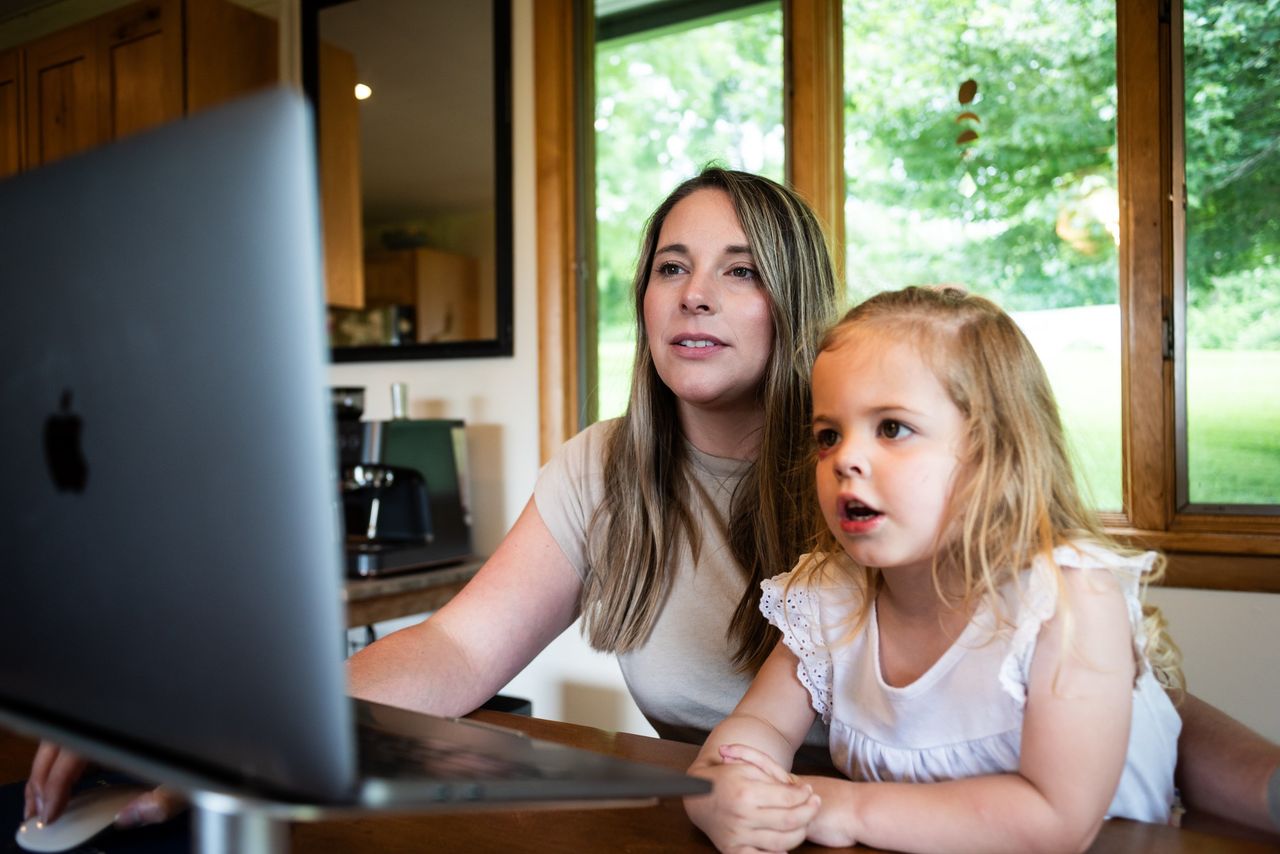More women than ever have entered the American workforce.
Heady demand for employees combined with more opportunities for remote work and a surge in female entrepreneurs are sending a flood of women into the labor market. Women now hold a record 79 million jobs, and the share of women in their prime working years who are employed or seeking work now stands at 77.9%, up from 75.8% five years ago.
But it’s not time for a victory lap just yet.
The same work-from-home opportunities that have enabled many moms in particular to enter or rejoin the workforce are also shackling them with fresh responsibilities. Many say they are effectively working two full-time jobs: managing their households and their careers.
Sarika Paralkar left her job in tech after giving birth to twin girls almost 10 years ago to focus on raising them. She recently started a full-time fellowship with her Oakland, Calif., city government focused on furthering local climate initiatives.
Since the position only requires Paralkar, 44, to be in the office a few times a month, she’s still able to shuttle her twins to and from school, camp, playdates and extracurricular activities. She thought that would make for an ideal compromise between being either at home or in an office full time. Instead, she often feels like she isn’t living up to her own expectations for herself as either a mother or an employee.
“As much as I appreciate the flexibility, I often feel like I would rather go into work so that I don’t have the constant drumbeat in my head of the chores that need to happen around the house,” she said.
Her husband, Vidyut Naware, has also been home four or so days a week since the pandemic and has stepped up. Still, “after nine years of me being the one who’s home all day, it’s hard for me to adjust,” she said.
Paralkar’s situation is becoming a new normal. Women in heterosexual partnerships still, on average, take on more of the child-raising bargain than do men. That means that work-from-home can exacerbate an existing gender divide, said Dartmouth College economics professor Claudia Olivetti.
Moms have to ask themselves: “Are you taking on more child care because you have a more flexible job, or did you take a more flexible job because you were already doing most of the child care?” Olivetti said.
How we got here
The share of prime-age women in the labor force has risen markedly since before the pandemic. That category refers to workers between the ages of 25 and 54, which means they have largely finished school and aren’t yet approaching their retirement years.
The percentage of women in that age group who are working or looking for work hit an all-time high of 78.1% in May, according to the Labor Department, before dropping slightly in June. There are now an additional 1.9 million prime-age women in the U.S. labor force than there were five years ago.
The path here hasn’t been entirely straightforward.
After decades of gains, the proportion of prime-age women working or looking for work stalled out in 2000. That share of women working was only just beginning to tick up when the pandemic hit—closing schools and driving millions of women into full-time caregiving.
The quick bounceback is in part a reflection of how strong the demand for workers has been . Case in point: Women are making up a growing share of typically male-dominated industries such as construction.
More women are also starting their own businesses. Less than a third of new companies in 2019 were founded by women, according to payroll provider Gusto’s analysis of census data and its own platform. Yet female founders started about half of all businesses every year since.
But the biggest change is the lasting impact of the pandemic’s remote work policies across companies and industries.
“Employers are recognizing they don’t want to lose the value moms can contribute,” said Misty Heggeness, an economist at the University of Kansas. “There’s been a lot more allowance and tolerance for some of these alternative work arrangements, and moms have really benefited from it—and so has the economy.”
To some degree, the women pouring into the workforce are doing so as a matter of necessity and not just opportunity. Rising costs are making it harder for families to live on just one paycheck. Women who leave their job for any extended period not only miss out on pay during that time, they also often lose out on raises and other benefits that come from longer tenure.
Still, the proportion of women in the U.S. labor market is smaller than the proportion of men—nearly 90% of prime-age men are part of the labor force as of June. And women continue to make 17% less than men at the same jobs, according to an analysis by Goldman Sachs .
Women in the U.S. are also less likely to be employed than many of their peers abroad. That’s due in part to the fact that caregiving for young children is considered a private responsibility in the U.S., unlike in many other high-income countries, said University of Miami economist Stefania Albanesi . Her work has shown that the U.S. devoted substantially less public spending, as a share of gross domestic product, to families than other developed countries.
In Japan, for example, the government put in place what it called “womenomics” policies a little over a decade ago that significantly increased the supply of child care, helping expand the ranks of women in the workforce. As of May, 83.3% of Japan’s prime-age women participated in the labor market, while Sweden is the world leader among advanced economies, at 90% as of the first quarter, according to the Organization for Economic Cooperation and Development.
Japan’s actions were driven by concern that, with an aging population, the country was running out of workers. The U.S. faces an aging problem, too: There are now only 2.2 Americans in their prime working years for each person 65 and older, down from 3.2 in 2010, the Congressional Budget Office estimates.
“One way to counter the issue of the aging population is just to get more people who are prime age working,” said Albanesi. Raising women’s participation “is an excellent way to do that,” she added. It also makes better use of women’s education levels: More women than men have college degrees.
Not your mother’s workplace
Mothers of young children have always been less likely to work than their childless peers. For many women, this has made for an uneasy calculus: Having children early in their work lives can stunt their careers, but putting them off can mean not having them at all.
The ability to do many jobs remotely is altering the kids-versus-career math. Last year, a record 68.9% of women with children under age 6 were in the labor force, up from 66.4% in 2019. Remarkably, this gain came even as pandemic-related disruptions often made child care harder to secure .
That’s creating a huge generational change.
When Camille Daigle had her three children in the 1980s and early ’90s, the only way she could think to keep working while being present for her kids was to start an in-home daycare.
“I didn’t have a fancy career, it’s just the way my life kind of went,” says Daigle, now 68 and living in Fayston, Vt.
Her daughter, Carmen Haslam, had more options when her first child was born a little under five years ago. Her role in customer service for a maple syrup manufacturer was already flexible, and she was able to switch to being permanently remote once the pandemic brought everyone home full-time.
“I just couldn’t find the path forward to making a 50-minute commute work,” said Haslam, 34, who lives in Moretown, Vt., with her husband, Nick, and 4- and 3-year-old kids.
By hiring Grandma Daigle to come watch the kids three days a week for $60 a day, the Haslams were able to save thousands of dollars a month on full-time daycare.

Camille Daigle used to run an in-home daycare. Now she helps her daughter and son-in-law save money on child care by looking after her grandchildren, Wes and Norah. PHOTO: IAN THOMAS JANSEN-LONNQUIST FOR WSJ
But with her husband, an insurance-claims examiner, now working in a hybrid capacity as well, Haslam has been relegated to spending the workday in the living room or at the kitchen table among the kids. Nick, meanwhile, uses the spare bedroom as an office.
“It’s much more acceptable for one of the kiddos to pop up on one of my calls than it would be for him,” she explained.
While Nick is a “true partner,” Haslam says tasks often fall to her by default. For their 4-year-old’s recent preschool graduation, for example, Haslam received an email asking for her to sign up to bring plates, cups, napkins and homemade muffins. Her husband received an invitation.
Economists Laura Gee and Olga Stoddard can relate. The duo often commiserated at conferences about how their children’s schools usually reached out to them, even when they were traveling, instead of to their husbands.
“Our spouses were very involved and very willing to be the primary contact person, and yet Laura and I were often handling a lot of these requests,” said Stoddard.
They teamed up with another economist, Kristy Buzard, and designed a study where they sent emails to school principals from fictitious mothers and fathers in different-sex parent households, providing phone numbers for both parents and asking for a call back. Moms got 1.4 times as many calls as dads.
Moms at the helm
As a nurse, Vanessa Cameron had long been accustomed to leaving her work at work and her parenting duties at home. When a 2021 accident left her a full-time wheelchair user, she switched to a virtual role, severing that separation.
For the most part, Cameron feels grateful that she was able to find a flexible job relatively easily working in nursing professional development. By making remote work widespread, “the pandemic opened up this entire world for people with disabilities,” said Cameron, who is 37 and lives in Leavenworth, Wash.
Indeed, more work-from-home opportunities have ushered many more people with disabilities, especially women, into the labor force. In June, 39% of women with a disability ages 16 to 64 were working or looking for work, up from 31.6% five years earlier.
Cameron’s job also allows her to adapt to her husband Tony’s nontraditional schedule as a brewer. But the realities of remote work have created new challenges, especially this summer while Cameron’s 10-year-old son, Jack, has been home with her all day. When she’s working, she feels guilty that she’s not mothering. When she’s mothering, she feels guilty that she’s not working.
She has been waking up at 5:30 a.m. to squeeze in physical therapy and an hour or two of work before Jack wakes up. She tries to take calls next to him, in the living room, so that he isn’t alone all day. That leaves very little time left over for herself or for a social life.
“I’m more mentally exhausted than I feel like I’ve been in quite awhile,” Cameron said.
Amber Messina’s five children are also home this summer, leaving her searching for windows to squeeze in accounting work between naps, chores and complaints of “I’m bored.”
“I’m kind of hiding while I’m trying to work in the afternoons,” said Messina. She often takes refuge at an outdoor patio table out of earshot and eyesight.
Her return to the workforce two years ago, after about a decade as a stay-at-home mom, enabled her husband, David, to take a pay cut. He stepped down from his job at a bank to fulfill a dream of becoming a teacher.
She now works between 15 to 20 hours a week from home in Riverdale, Utah, at the all-female accounting firm BookSmarts, a Utah-based company founded in part with the intention of being more accommodating to moms. Since her two preschoolers are home with her year-round, she tries to schedule training sessions over the summer when her three school-age children are home to help care for them.
“It gets hard,” said Messina, 36. “I’m definitely not able to take my younger kids to the park as much as I did with the older ones.”
Write to Rachel Wolfe at rachel.wolfe@wsj.com and Justin Lahart at Justin.Lahart@wsj.com



